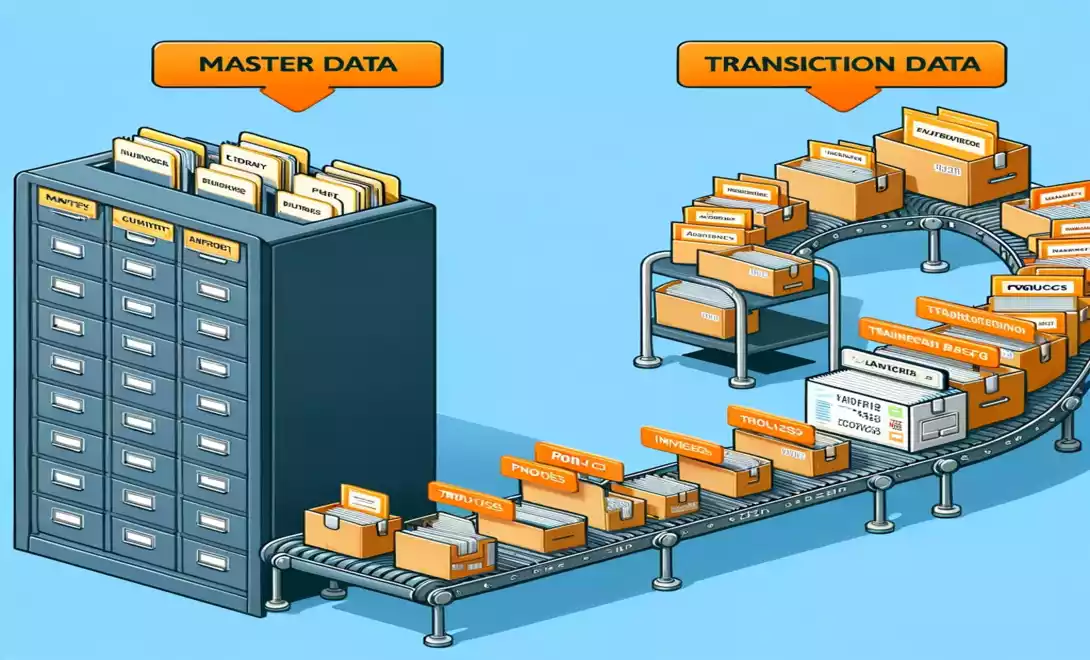Master data and Transaction data are two fundamental categories of data that serve distinct purposes within an organization. Understanding the differences between these two types of data is crucial for optimizing business processes and leveraging data-driven insights effectively.
What is Master Data?
Master Data refers to the core, persistent, and foundational information that is essential for the operations and decision-making processes of an organization. It represents the key entities and attributes that define the business and its relationships. Master data provides a single, consistent view of essential data elements, such as customers, products, suppliers, employees, and other critical entities.

Characteristics of Master Data:
Persistence: Master data is relatively static and remains unchanged over a longer period.
- Reusability: It is shared across multiple systems and business processes.
- Uniqueness: Each master data record is unique and identified by a primary key.
- Integrity: Master data is maintained with high standards of accuracy and consistency.
- Centralization: It is typically managed and governed centrally to ensure data quality and consistency across the organization.
- Cross-functional: Master data is used by multiple departments or functions within an organization.
Examples of Master Data in different industries:
- Customer Master Data: Includes customer details like name, address, contact information, and payment terms.
- Product Master Data: Contains information about products such as name, description, specifications, and pricing.
- Supplier Master Data: Consists of information about suppliers, such as name, address, contact details, and payment terms.
- Employee Master Data: Holds employee details like name, designation, department, and contact information.
- Financial Master Data: Includes information about financial entities like general ledger accounts, cost centers, and profit centers.
Master data serves as a reference and context for transactional data. It provides a reliable foundation for business operations, analysis, reporting, and decision-making processes. Effective management and governance of master data are crucial to ensure data quality, accuracy, consistency, and reliability throughout the organization.
What is Transaction Data?
Transaction Data refers to information regarding business events or activities occurring within an organization, and includes records about individual transactions, processes or actions occurring as part of standard operations.

Characteristics of Transaction Data:
- Dynamism: Transaction data is constantly changing as new transactions occur.
- Event-driven: It captures specific events or actions, such as sales orders, purchases, invoices, payments, etc.
- Temporal: Transaction data is time-stamped to indicate when the event or action occurred.
- Granularity: It provides detailed information at a transactional level, including quantities, amounts, dates, and other relevant attributes.
- Contextual: Transaction data is often associated with related master data, providing a complete picture of the event.
Examples of Transaction Data in different business processes:
- Sales Transactions: Includes records of customer orders, sales invoices, sales receipts, and related details.
- Purchase Transactions: Covers purchase orders, vendor invoices, payments made to suppliers, and related information.
- Financial Transactions: Includes records of cash inflows, cash outflows, journal entries, and general ledger postings.
- Inventory Transactions: Tracks changes in inventory levels due to stock receipts, issues, transfers, or adjustments.
- Production Transactions: Captures details of production orders, work orders, manufacturing processes, and resource consumption.
Transaction data is crucial for operational monitoring, analysis, and reporting. It provides valuable insights into business activities, financial performance, inventory levels, customer behavior, and other operational metrics. Effective management and analysis of transaction data can help organizations identify trends, anomalies, and patterns, enabling informed decision-making and process optimization.
It’s worth noting that transaction data is often stored in transactional databases or systems, separate from master data, which is more persistent and foundational.
Differences between Master Data and Transaction Data
Here’s a comparison chart outlining the key differences between Master Data and Transaction Data:
| Aspect | Master Data | Transaction Data |
|---|---|---|
| Nature | Static and stable | Dynamic and frequently changing |
| Purpose | Provides context and structure | Records specific events or activities |
| Examples | Customer data, product data, employee data | Sales transactions, financial transactions, inventory movements |
| Data Volume | Relatively small in volume | Can be vast and rapidly increasing |
| Update Frequency | Infrequent updates | Frequent updates |
| Usage | Used for reference and context | Used for real-time decision-making |
| Impact on Operations | Critical for core operations | Supports day-to-day operations |
| Importance of Accuracy | High must be accurate and consistent | Critical accuracy is paramount for decision-making |
| Data Lifecycle | Long-term, relatively stable | Short-term, frequently changing |
| Data Governance | Requires strict governance to maintain integrity | Still requires governance but may have less rigid rules |
| Storage | Typically stored in Master Data Management (MDM) systems | Stored in transactional databases |
| Integration | Integrated across systems to ensure consistency | Integrated with other transactional data sources |
| Reporting and Analysis | Used for reporting and analysis over time | Used for real-time analytics and reporting |
| Security and Privacy Concerns | Important for maintaining data quality and compliance | Crucial to protect sensitive transactional information |
| Examples of Tools and Systems | MDM systems, data warehouses, data integration tools | Relational databases, ERP systems, data processing platforms |
The Relationship between Master Data and Transaction Data
The relationship between Master Data and Transaction Data is closely intertwined. Master Data provides the foundational context and reference for Transaction Data, while Transaction Data relies on Master Data for accuracy and consistency.
Here’s a closer look at their relationship:
- Context and Reference: Master Data provides the necessary context and reference for Transaction Data. It establishes the fundamental entities, attributes, and relationships that are essential for understanding and interpreting transactional events. For example, in a sales transaction, Master Data would define the customer, product, and pricing information, while Transaction Data would capture the specific details of the sales order.
- Accuracy and Consistency: Transaction Data relies on Master Data to ensure accuracy and consistency. Master Data acts as a centralized and trusted source of information, ensuring that the transactional records are associated with the correct entities and that the data entered is valid and in line with established business rules. For instance, Master Data would validate that the customer mentioned in a sales transaction exists and has the correct billing address.
- Data Integration and Enrichment: Master Data and Transaction Data can be integrated to enrich the understanding and analysis of business activities. By combining the two data types, organizations can gain deeper insights into transactional trends, customer behavior, product performance, and financial metrics. For instance, analyzing sales transactions alongside customer master data can help identify buying patterns or segment customers for targeted marketing campaigns.
- Data Governance and Management: Master Data and Transaction Data require different governance and management approaches. Master Data necessitates centralized governance to ensure consistency, data quality, and integrity across the organization. Transaction Data, on the other hand, is managed in decentralized systems or databases to facilitate real-time processing and operational efficiency. Both data types benefit from data governance practices that establish data standards, policies, and stewardship.
- Data Lifecycle: Master Data typically has a longer lifecycle compared to Transaction Data. Master Data is maintained and updated periodically, reflecting changes in core entities and attributes. Transaction Data, on the other hand, has a shorter lifecycle and is generated in real-time or near-real-time as individual transactions occur.
- Transaction Data: This may be retained for a specific period for auditing, compliance, or analytical purposes before being archived or purged. Understanding the relationship between Master Data and Transaction Data is crucial for ensuring data accuracy, consistency, and reliability throughout the organization. Effective integration, management, and governance of both data types contribute to better decision-making, operational efficiency, and improved customer experiences.
Best Practices for Master Data and Transaction Data Management
Managing Master Data and Transaction Data effectively is crucial for maintaining data quality, accuracy, and consistency within an organization.
Here are some best practices for Master Data and Transaction Data management:
Master Data Management (MDM) Best Practices:
- Centralize Data Governance: Establish a centralized governance framework for managing Master Data. This includes defining data ownership, roles, and responsibilities, as well as implementing data stewardship practices to ensure ongoing data quality and consistency.
- Implement Data Standards: Define and enforce data standards for Master Data, including naming conventions, data formats, and validation rules. Consistent standards help maintain data integrity and facilitate integration across systems.
- Establish Data Quality Management: Develop processes and tools to monitor and improve data quality. Regularly assess the accuracy, completeness, and consistency of Master Data, and address any identified issues through data cleansing and enrichment activities.
- Enable Data Integration: Implement integration mechanisms and technologies to synchronize Master Data across different systems and applications. This ensures a single, unified view of Master Data across the organization and eliminates data silos.
- Provide Data Access Controls: Implement appropriate access controls and permissions to ensure data security and privacy. Define roles and permissions for accessing and modifying Master Data based on the user’s job function and responsibilities.
Transaction Data Management Best Practices:
- Capture Data in Real-time: To guarantee accurate and timely information is readily available for decision-making and operational processes, Transaction Data must be captured in real-time and recorded as it happens.
- Automate Data Capture: Utilize automation technologies to capture Transaction Data directly from the source systems, reducing manual data entry and minimizing the risk of errors or delays.
- Validate and Cleanse Data: Implement validation rules and data cleansing techniques to ensure the accuracy and integrity of Transaction Data. This includes performing data validation checks, removing duplicate records, and correcting any inaccuracies or inconsistencies.
- Implement Auditing and Tracking: Establish mechanisms to track and audit Transaction Data, including capturing the history of changes and maintaining an audit trail for compliance and regulatory purposes.
- Integrate Transaction Data with Master Data: Ensure that Transaction Data is integrated with the relevant Master Data to provide a complete and accurate view of business activities. This integration enhances data analysis, reporting, and decision-making processes.
- Retain Data for Compliance: Define data retention policies and procedures to retain Transaction Data for the required period to meet legal, regulatory, and compliance requirements. Ensure that data is archived or purged appropriately when it is no longer needed.
- Monitor Data Quality: Continuously monitor the quality of Transaction Data to identify anomalies, errors, or inconsistencies. Implement data quality controls and conduct regular data quality assessments to proactively address any issues.
Following these best practices will enable organizations to ensure the accuracy, consistency, and integrity of Master Data as well as Transaction Data for better decision-making, operational efficiencies improvements, and outcomes improvement.
Conclusion
Master Data and Transaction Data are two sides of the same coin in the world of data management. While Master Data provides the foundation, Transaction Data adds the dynamism required for businesses to thrive. Effective management of both types of data can drive operational efficiency, facilitate data-driven decision-making, and open new avenues for growth and innovation.



